MG411: People Management - Leadership, Training, Talent at Nissan
VerifiedAdded on 2023/01/18
|10
|2817
|84
Report
AI Summary
This report provides an analysis of people management at Nissan, focusing on three key areas: leadership and management, training and development, and talent management. It examines the operational context of the organization within each area, explores relevant theoretical models such as contingency theory, behavioral theory, system model, transitional model, instructional system development model and expectancy theory, and provides recommendations for improving management practices. The report emphasizes the importance of aligning these people management strategies with the company's goals to enhance employee performance and achieve long-term business success. It concludes by highlighting the significance of talent management in hiring and retaining skilled employees to drive organizational growth.
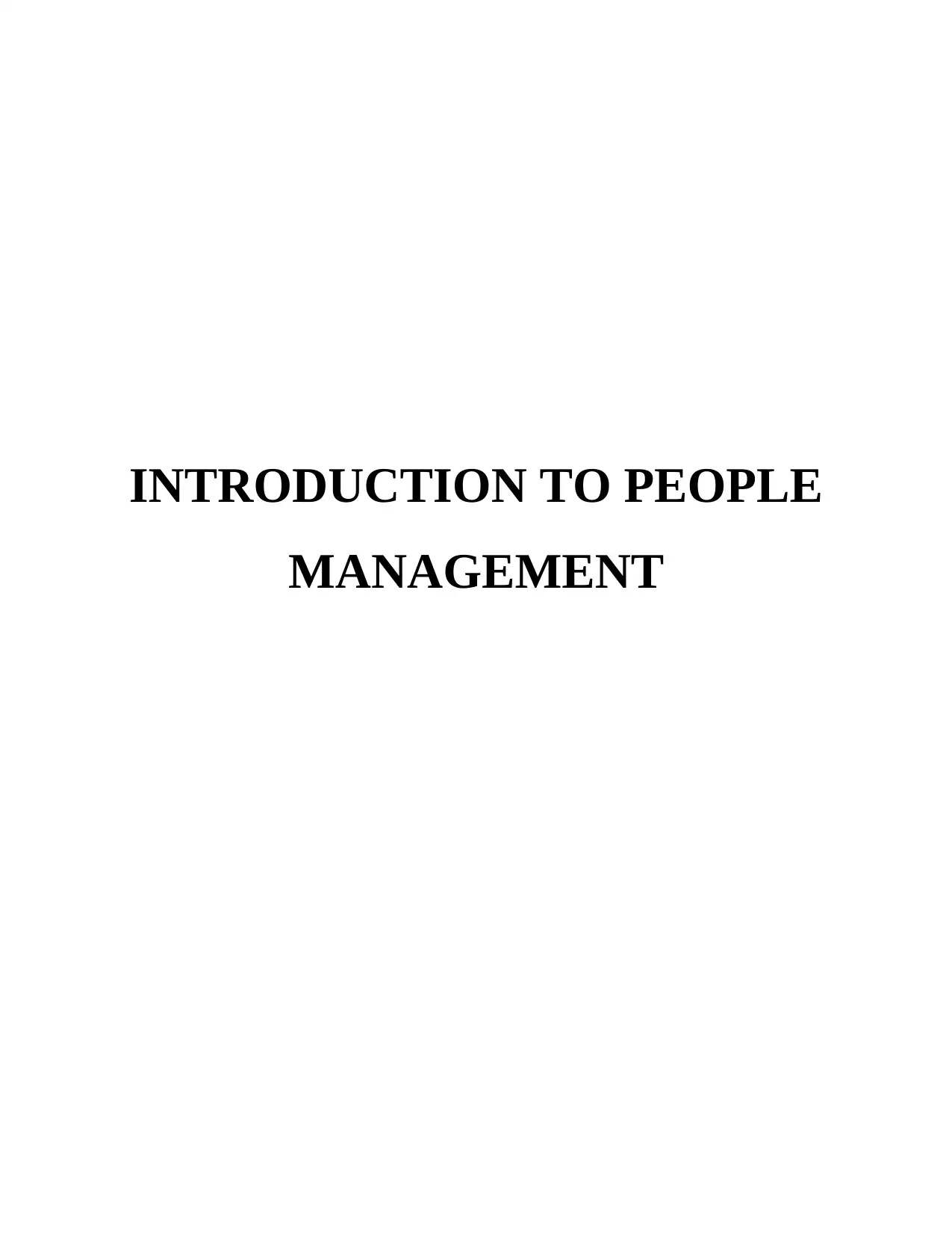
INTRODUCTION TO PEOPLE
MANAGEMENT
MANAGEMENT
Paraphrase This Document
Need a fresh take? Get an instant paraphrase of this document with our AI Paraphraser
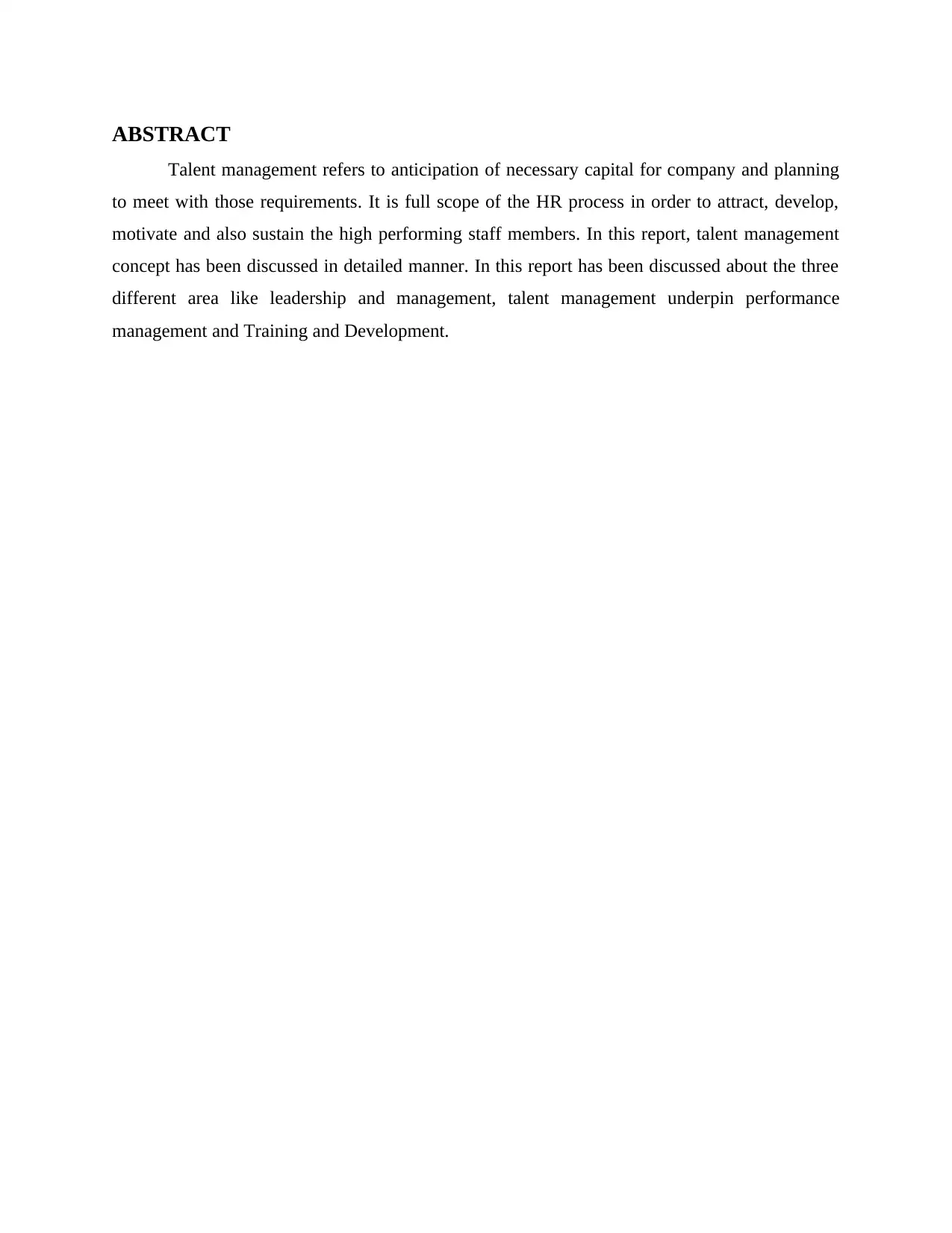
ABSTRACT
Talent management refers to anticipation of necessary capital for company and planning
to meet with those requirements. It is full scope of the HR process in order to attract, develop,
motivate and also sustain the high performing staff members. In this report, talent management
concept has been discussed in detailed manner. In this report has been discussed about the three
different area like leadership and management, talent management underpin performance
management and Training and Development.
Talent management refers to anticipation of necessary capital for company and planning
to meet with those requirements. It is full scope of the HR process in order to attract, develop,
motivate and also sustain the high performing staff members. In this report, talent management
concept has been discussed in detailed manner. In this report has been discussed about the three
different area like leadership and management, talent management underpin performance
management and Training and Development.
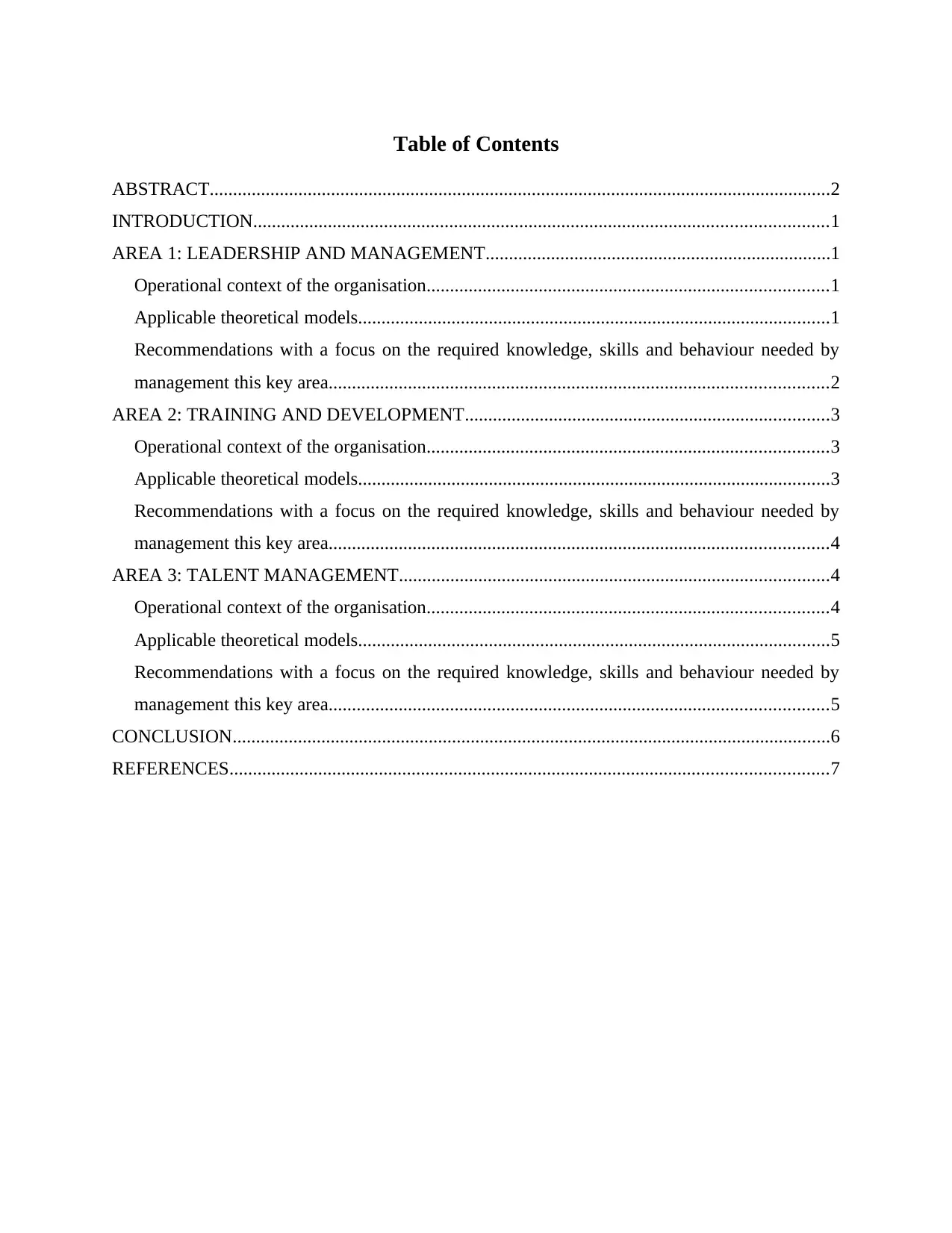
Table of Contents
ABSTRACT.....................................................................................................................................2
INTRODUCTION...........................................................................................................................1
AREA 1: LEADERSHIP AND MANAGEMENT..........................................................................1
Operational context of the organisation......................................................................................1
Applicable theoretical models.....................................................................................................1
Recommendations with a focus on the required knowledge, skills and behaviour needed by
management this key area...........................................................................................................2
AREA 2: TRAINING AND DEVELOPMENT..............................................................................3
Operational context of the organisation......................................................................................3
Applicable theoretical models.....................................................................................................3
Recommendations with a focus on the required knowledge, skills and behaviour needed by
management this key area...........................................................................................................4
AREA 3: TALENT MANAGEMENT............................................................................................4
Operational context of the organisation......................................................................................4
Applicable theoretical models.....................................................................................................5
Recommendations with a focus on the required knowledge, skills and behaviour needed by
management this key area...........................................................................................................5
CONCLUSION................................................................................................................................6
REFERENCES................................................................................................................................7
ABSTRACT.....................................................................................................................................2
INTRODUCTION...........................................................................................................................1
AREA 1: LEADERSHIP AND MANAGEMENT..........................................................................1
Operational context of the organisation......................................................................................1
Applicable theoretical models.....................................................................................................1
Recommendations with a focus on the required knowledge, skills and behaviour needed by
management this key area...........................................................................................................2
AREA 2: TRAINING AND DEVELOPMENT..............................................................................3
Operational context of the organisation......................................................................................3
Applicable theoretical models.....................................................................................................3
Recommendations with a focus on the required knowledge, skills and behaviour needed by
management this key area...........................................................................................................4
AREA 3: TALENT MANAGEMENT............................................................................................4
Operational context of the organisation......................................................................................4
Applicable theoretical models.....................................................................................................5
Recommendations with a focus on the required knowledge, skills and behaviour needed by
management this key area...........................................................................................................5
CONCLUSION................................................................................................................................6
REFERENCES................................................................................................................................7
⊘ This is a preview!⊘
Do you want full access?
Subscribe today to unlock all pages.

Trusted by 1+ million students worldwide
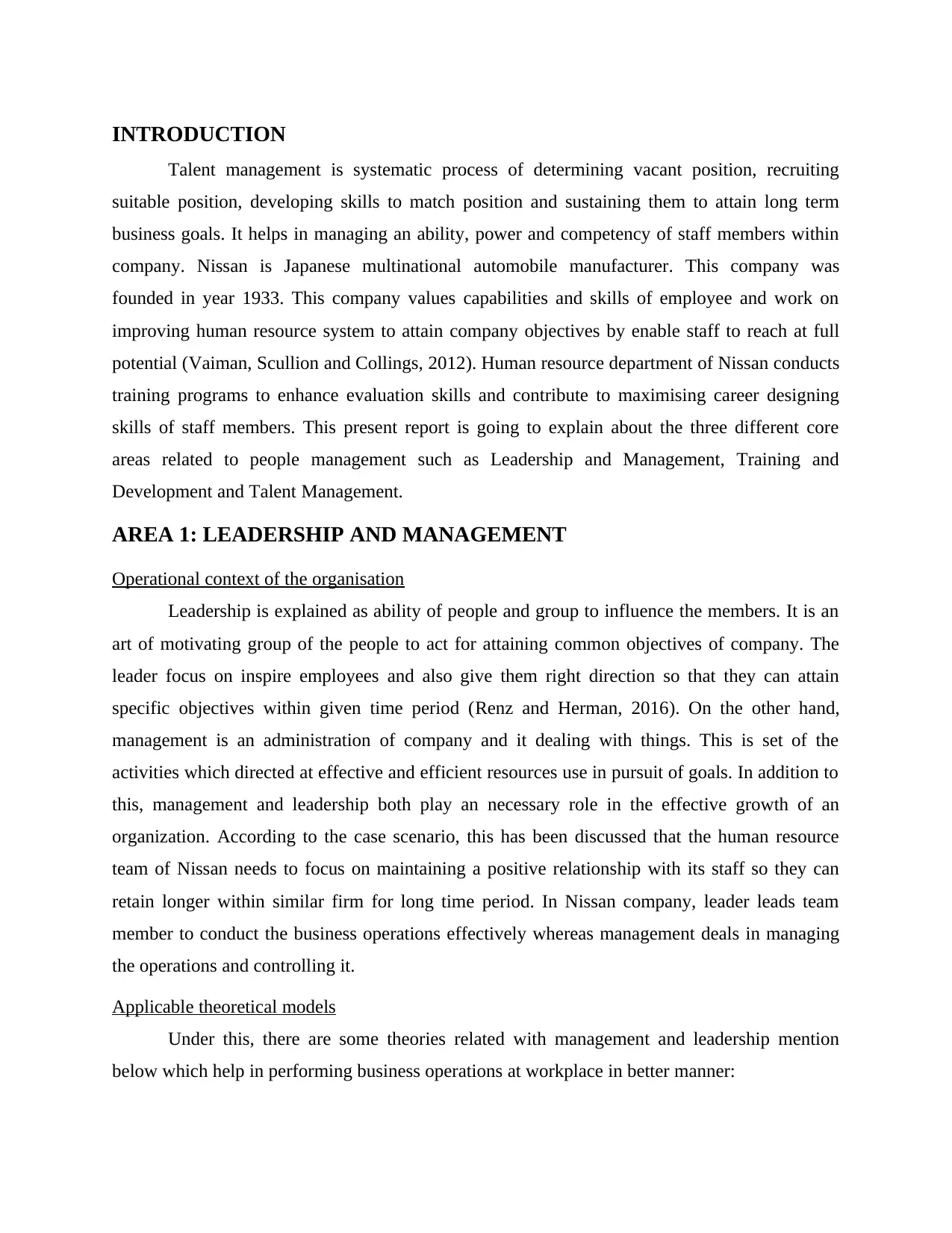
INTRODUCTION
Talent management is systematic process of determining vacant position, recruiting
suitable position, developing skills to match position and sustaining them to attain long term
business goals. It helps in managing an ability, power and competency of staff members within
company. Nissan is Japanese multinational automobile manufacturer. This company was
founded in year 1933. This company values capabilities and skills of employee and work on
improving human resource system to attain company objectives by enable staff to reach at full
potential (Vaiman, Scullion and Collings, 2012). Human resource department of Nissan conducts
training programs to enhance evaluation skills and contribute to maximising career designing
skills of staff members. This present report is going to explain about the three different core
areas related to people management such as Leadership and Management, Training and
Development and Talent Management.
AREA 1: LEADERSHIP AND MANAGEMENT
Operational context of the organisation
Leadership is explained as ability of people and group to influence the members. It is an
art of motivating group of the people to act for attaining common objectives of company. The
leader focus on inspire employees and also give them right direction so that they can attain
specific objectives within given time period (Renz and Herman, 2016). On the other hand,
management is an administration of company and it dealing with things. This is set of the
activities which directed at effective and efficient resources use in pursuit of goals. In addition to
this, management and leadership both play an necessary role in the effective growth of an
organization. According to the case scenario, this has been discussed that the human resource
team of Nissan needs to focus on maintaining a positive relationship with its staff so they can
retain longer within similar firm for long time period. In Nissan company, leader leads team
member to conduct the business operations effectively whereas management deals in managing
the operations and controlling it.
Applicable theoretical models
Under this, there are some theories related with management and leadership mention
below which help in performing business operations at workplace in better manner:
Talent management is systematic process of determining vacant position, recruiting
suitable position, developing skills to match position and sustaining them to attain long term
business goals. It helps in managing an ability, power and competency of staff members within
company. Nissan is Japanese multinational automobile manufacturer. This company was
founded in year 1933. This company values capabilities and skills of employee and work on
improving human resource system to attain company objectives by enable staff to reach at full
potential (Vaiman, Scullion and Collings, 2012). Human resource department of Nissan conducts
training programs to enhance evaluation skills and contribute to maximising career designing
skills of staff members. This present report is going to explain about the three different core
areas related to people management such as Leadership and Management, Training and
Development and Talent Management.
AREA 1: LEADERSHIP AND MANAGEMENT
Operational context of the organisation
Leadership is explained as ability of people and group to influence the members. It is an
art of motivating group of the people to act for attaining common objectives of company. The
leader focus on inspire employees and also give them right direction so that they can attain
specific objectives within given time period (Renz and Herman, 2016). On the other hand,
management is an administration of company and it dealing with things. This is set of the
activities which directed at effective and efficient resources use in pursuit of goals. In addition to
this, management and leadership both play an necessary role in the effective growth of an
organization. According to the case scenario, this has been discussed that the human resource
team of Nissan needs to focus on maintaining a positive relationship with its staff so they can
retain longer within similar firm for long time period. In Nissan company, leader leads team
member to conduct the business operations effectively whereas management deals in managing
the operations and controlling it.
Applicable theoretical models
Under this, there are some theories related with management and leadership mention
below which help in performing business operations at workplace in better manner:
Paraphrase This Document
Need a fresh take? Get an instant paraphrase of this document with our AI Paraphraser
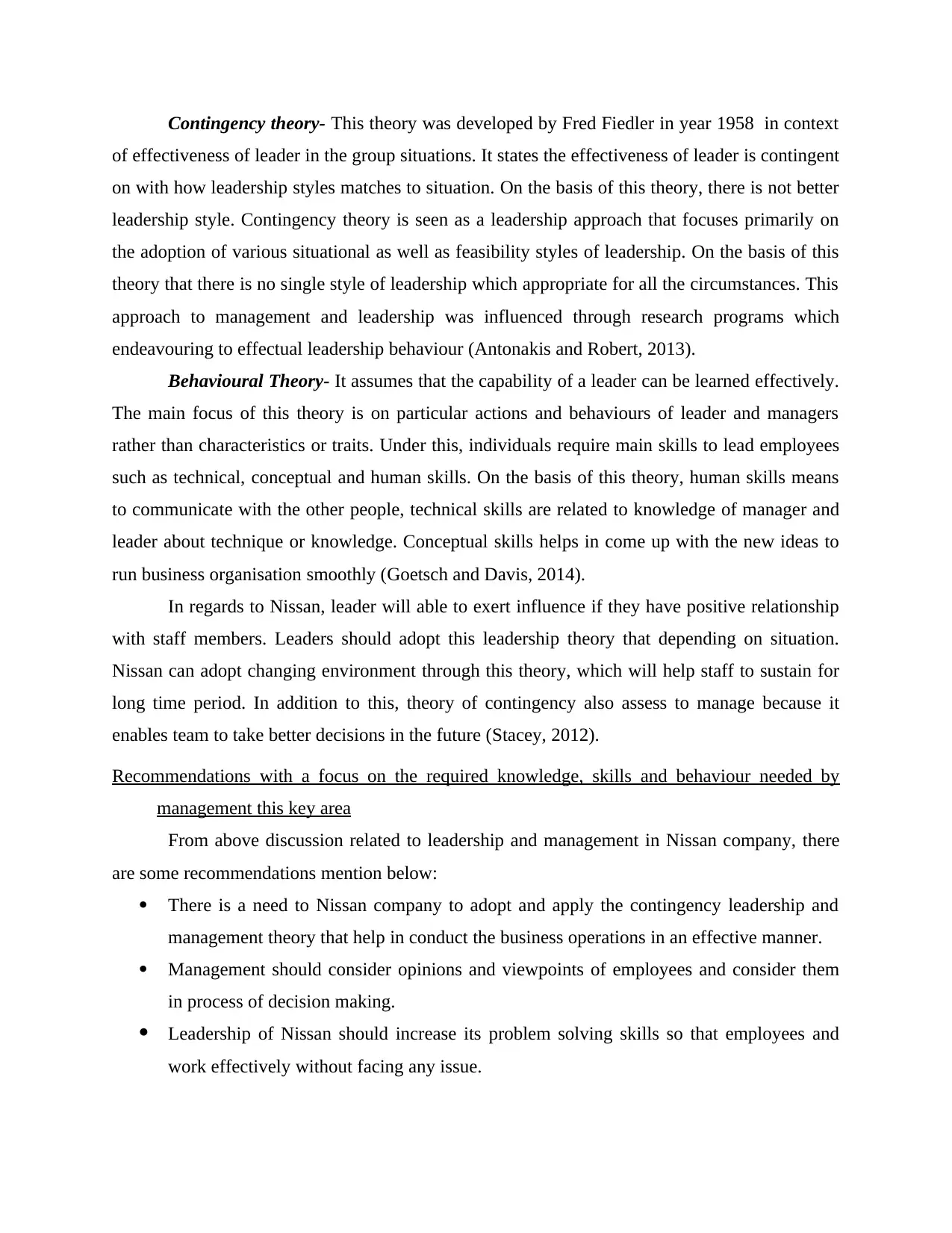
Contingency theory- This theory was developed by Fred Fiedler in year 1958 in context
of effectiveness of leader in the group situations. It states the effectiveness of leader is contingent
on with how leadership styles matches to situation. On the basis of this theory, there is not better
leadership style. Contingency theory is seen as a leadership approach that focuses primarily on
the adoption of various situational as well as feasibility styles of leadership. On the basis of this
theory that there is no single style of leadership which appropriate for all the circumstances. This
approach to management and leadership was influenced through research programs which
endeavouring to effectual leadership behaviour (Antonakis and Robert, 2013).
Behavioural Theory- It assumes that the capability of a leader can be learned effectively.
The main focus of this theory is on particular actions and behaviours of leader and managers
rather than characteristics or traits. Under this, individuals require main skills to lead employees
such as technical, conceptual and human skills. On the basis of this theory, human skills means
to communicate with the other people, technical skills are related to knowledge of manager and
leader about technique or knowledge. Conceptual skills helps in come up with the new ideas to
run business organisation smoothly (Goetsch and Davis, 2014).
In regards to Nissan, leader will able to exert influence if they have positive relationship
with staff members. Leaders should adopt this leadership theory that depending on situation.
Nissan can adopt changing environment through this theory, which will help staff to sustain for
long time period. In addition to this, theory of contingency also assess to manage because it
enables team to take better decisions in the future (Stacey, 2012).
Recommendations with a focus on the required knowledge, skills and behaviour needed by
management this key area
From above discussion related to leadership and management in Nissan company, there
are some recommendations mention below:
There is a need to Nissan company to adopt and apply the contingency leadership and
management theory that help in conduct the business operations in an effective manner.
Management should consider opinions and viewpoints of employees and consider them
in process of decision making.
Leadership of Nissan should increase its problem solving skills so that employees and
work effectively without facing any issue.
of effectiveness of leader in the group situations. It states the effectiveness of leader is contingent
on with how leadership styles matches to situation. On the basis of this theory, there is not better
leadership style. Contingency theory is seen as a leadership approach that focuses primarily on
the adoption of various situational as well as feasibility styles of leadership. On the basis of this
theory that there is no single style of leadership which appropriate for all the circumstances. This
approach to management and leadership was influenced through research programs which
endeavouring to effectual leadership behaviour (Antonakis and Robert, 2013).
Behavioural Theory- It assumes that the capability of a leader can be learned effectively.
The main focus of this theory is on particular actions and behaviours of leader and managers
rather than characteristics or traits. Under this, individuals require main skills to lead employees
such as technical, conceptual and human skills. On the basis of this theory, human skills means
to communicate with the other people, technical skills are related to knowledge of manager and
leader about technique or knowledge. Conceptual skills helps in come up with the new ideas to
run business organisation smoothly (Goetsch and Davis, 2014).
In regards to Nissan, leader will able to exert influence if they have positive relationship
with staff members. Leaders should adopt this leadership theory that depending on situation.
Nissan can adopt changing environment through this theory, which will help staff to sustain for
long time period. In addition to this, theory of contingency also assess to manage because it
enables team to take better decisions in the future (Stacey, 2012).
Recommendations with a focus on the required knowledge, skills and behaviour needed by
management this key area
From above discussion related to leadership and management in Nissan company, there
are some recommendations mention below:
There is a need to Nissan company to adopt and apply the contingency leadership and
management theory that help in conduct the business operations in an effective manner.
Management should consider opinions and viewpoints of employees and consider them
in process of decision making.
Leadership of Nissan should increase its problem solving skills so that employees and
work effectively without facing any issue.
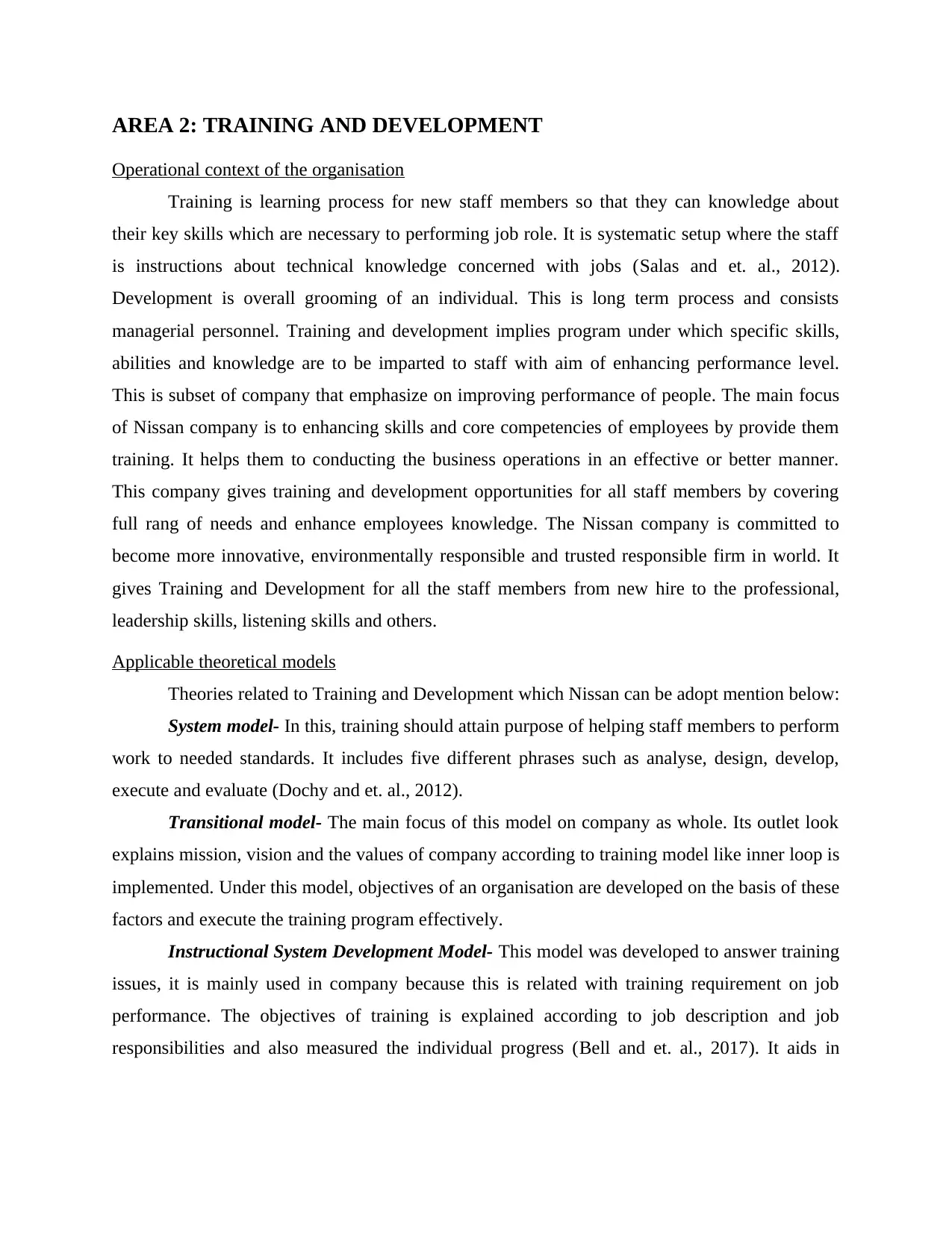
AREA 2: TRAINING AND DEVELOPMENT
Operational context of the organisation
Training is learning process for new staff members so that they can knowledge about
their key skills which are necessary to performing job role. It is systematic setup where the staff
is instructions about technical knowledge concerned with jobs (Salas and et. al., 2012).
Development is overall grooming of an individual. This is long term process and consists
managerial personnel. Training and development implies program under which specific skills,
abilities and knowledge are to be imparted to staff with aim of enhancing performance level.
This is subset of company that emphasize on improving performance of people. The main focus
of Nissan company is to enhancing skills and core competencies of employees by provide them
training. It helps them to conducting the business operations in an effective or better manner.
This company gives training and development opportunities for all staff members by covering
full rang of needs and enhance employees knowledge. The Nissan company is committed to
become more innovative, environmentally responsible and trusted responsible firm in world. It
gives Training and Development for all the staff members from new hire to the professional,
leadership skills, listening skills and others.
Applicable theoretical models
Theories related to Training and Development which Nissan can be adopt mention below:
System model- In this, training should attain purpose of helping staff members to perform
work to needed standards. It includes five different phrases such as analyse, design, develop,
execute and evaluate (Dochy and et. al., 2012).
Transitional model- The main focus of this model on company as whole. Its outlet look
explains mission, vision and the values of company according to training model like inner loop is
implemented. Under this model, objectives of an organisation are developed on the basis of these
factors and execute the training program effectively.
Instructional System Development Model- This model was developed to answer training
issues, it is mainly used in company because this is related with training requirement on job
performance. The objectives of training is explained according to job description and job
responsibilities and also measured the individual progress (Bell and et. al., 2017). It aids in
Operational context of the organisation
Training is learning process for new staff members so that they can knowledge about
their key skills which are necessary to performing job role. It is systematic setup where the staff
is instructions about technical knowledge concerned with jobs (Salas and et. al., 2012).
Development is overall grooming of an individual. This is long term process and consists
managerial personnel. Training and development implies program under which specific skills,
abilities and knowledge are to be imparted to staff with aim of enhancing performance level.
This is subset of company that emphasize on improving performance of people. The main focus
of Nissan company is to enhancing skills and core competencies of employees by provide them
training. It helps them to conducting the business operations in an effective or better manner.
This company gives training and development opportunities for all staff members by covering
full rang of needs and enhance employees knowledge. The Nissan company is committed to
become more innovative, environmentally responsible and trusted responsible firm in world. It
gives Training and Development for all the staff members from new hire to the professional,
leadership skills, listening skills and others.
Applicable theoretical models
Theories related to Training and Development which Nissan can be adopt mention below:
System model- In this, training should attain purpose of helping staff members to perform
work to needed standards. It includes five different phrases such as analyse, design, develop,
execute and evaluate (Dochy and et. al., 2012).
Transitional model- The main focus of this model on company as whole. Its outlet look
explains mission, vision and the values of company according to training model like inner loop is
implemented. Under this model, objectives of an organisation are developed on the basis of these
factors and execute the training program effectively.
Instructional System Development Model- This model was developed to answer training
issues, it is mainly used in company because this is related with training requirement on job
performance. The objectives of training is explained according to job description and job
responsibilities and also measured the individual progress (Bell and et. al., 2017). It aids in
⊘ This is a preview!⊘
Do you want full access?
Subscribe today to unlock all pages.

Trusted by 1+ million students worldwide
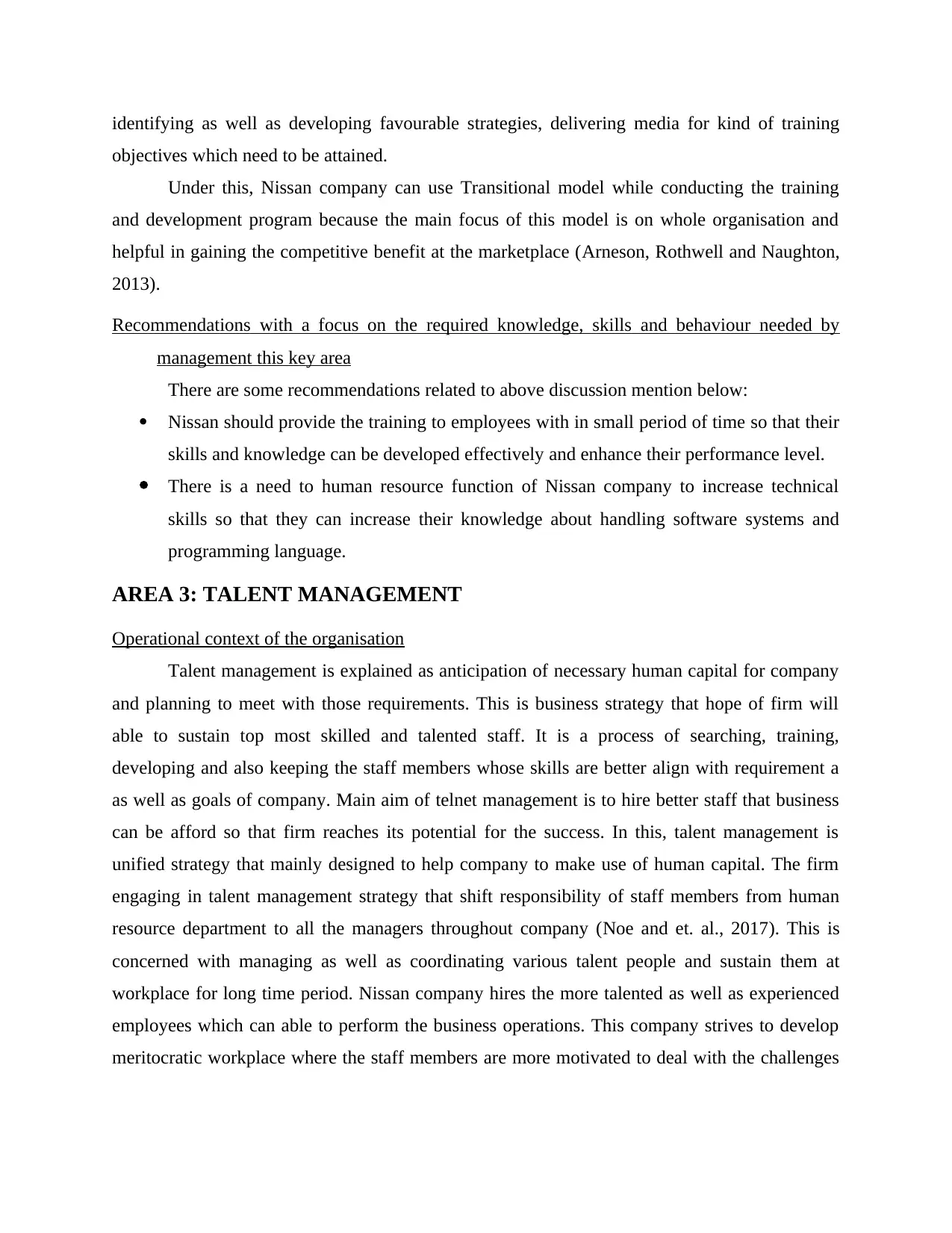
identifying as well as developing favourable strategies, delivering media for kind of training
objectives which need to be attained.
Under this, Nissan company can use Transitional model while conducting the training
and development program because the main focus of this model is on whole organisation and
helpful in gaining the competitive benefit at the marketplace (Arneson, Rothwell and Naughton,
2013).
Recommendations with a focus on the required knowledge, skills and behaviour needed by
management this key area
There are some recommendations related to above discussion mention below:
Nissan should provide the training to employees with in small period of time so that their
skills and knowledge can be developed effectively and enhance their performance level.
There is a need to human resource function of Nissan company to increase technical
skills so that they can increase their knowledge about handling software systems and
programming language.
AREA 3: TALENT MANAGEMENT
Operational context of the organisation
Talent management is explained as anticipation of necessary human capital for company
and planning to meet with those requirements. This is business strategy that hope of firm will
able to sustain top most skilled and talented staff. It is a process of searching, training,
developing and also keeping the staff members whose skills are better align with requirement a
as well as goals of company. Main aim of telnet management is to hire better staff that business
can be afford so that firm reaches its potential for the success. In this, talent management is
unified strategy that mainly designed to help company to make use of human capital. The firm
engaging in talent management strategy that shift responsibility of staff members from human
resource department to all the managers throughout company (Noe and et. al., 2017). This is
concerned with managing as well as coordinating various talent people and sustain them at
workplace for long time period. Nissan company hires the more talented as well as experienced
employees which can able to perform the business operations. This company strives to develop
meritocratic workplace where the staff members are more motivated to deal with the challenges
objectives which need to be attained.
Under this, Nissan company can use Transitional model while conducting the training
and development program because the main focus of this model is on whole organisation and
helpful in gaining the competitive benefit at the marketplace (Arneson, Rothwell and Naughton,
2013).
Recommendations with a focus on the required knowledge, skills and behaviour needed by
management this key area
There are some recommendations related to above discussion mention below:
Nissan should provide the training to employees with in small period of time so that their
skills and knowledge can be developed effectively and enhance their performance level.
There is a need to human resource function of Nissan company to increase technical
skills so that they can increase their knowledge about handling software systems and
programming language.
AREA 3: TALENT MANAGEMENT
Operational context of the organisation
Talent management is explained as anticipation of necessary human capital for company
and planning to meet with those requirements. This is business strategy that hope of firm will
able to sustain top most skilled and talented staff. It is a process of searching, training,
developing and also keeping the staff members whose skills are better align with requirement a
as well as goals of company. Main aim of telnet management is to hire better staff that business
can be afford so that firm reaches its potential for the success. In this, talent management is
unified strategy that mainly designed to help company to make use of human capital. The firm
engaging in talent management strategy that shift responsibility of staff members from human
resource department to all the managers throughout company (Noe and et. al., 2017). This is
concerned with managing as well as coordinating various talent people and sustain them at
workplace for long time period. Nissan company hires the more talented as well as experienced
employees which can able to perform the business operations. This company strives to develop
meritocratic workplace where the staff members are more motivated to deal with the challenges
Paraphrase This Document
Need a fresh take? Get an instant paraphrase of this document with our AI Paraphraser
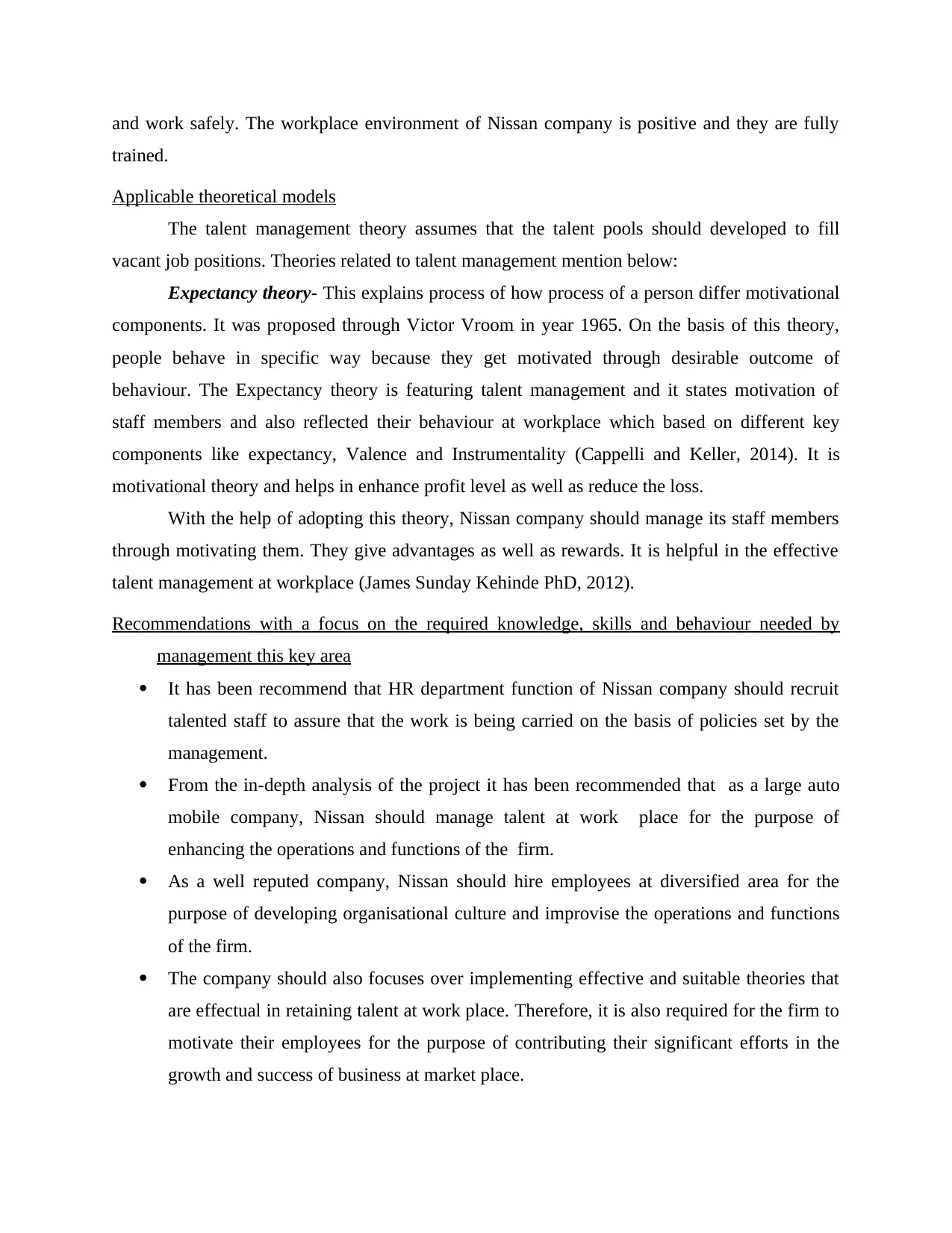
and work safely. The workplace environment of Nissan company is positive and they are fully
trained.
Applicable theoretical models
The talent management theory assumes that the talent pools should developed to fill
vacant job positions. Theories related to talent management mention below:
Expectancy theory- This explains process of how process of a person differ motivational
components. It was proposed through Victor Vroom in year 1965. On the basis of this theory,
people behave in specific way because they get motivated through desirable outcome of
behaviour. The Expectancy theory is featuring talent management and it states motivation of
staff members and also reflected their behaviour at workplace which based on different key
components like expectancy, Valence and Instrumentality (Cappelli and Keller, 2014). It is
motivational theory and helps in enhance profit level as well as reduce the loss.
With the help of adopting this theory, Nissan company should manage its staff members
through motivating them. They give advantages as well as rewards. It is helpful in the effective
talent management at workplace (James Sunday Kehinde PhD, 2012).
Recommendations with a focus on the required knowledge, skills and behaviour needed by
management this key area
It has been recommend that HR department function of Nissan company should recruit
talented staff to assure that the work is being carried on the basis of policies set by the
management.
From the in-depth analysis of the project it has been recommended that as a large auto
mobile company, Nissan should manage talent at work place for the purpose of
enhancing the operations and functions of the firm.
As a well reputed company, Nissan should hire employees at diversified area for the
purpose of developing organisational culture and improvise the operations and functions
of the firm.
The company should also focuses over implementing effective and suitable theories that
are effectual in retaining talent at work place. Therefore, it is also required for the firm to
motivate their employees for the purpose of contributing their significant efforts in the
growth and success of business at market place.
trained.
Applicable theoretical models
The talent management theory assumes that the talent pools should developed to fill
vacant job positions. Theories related to talent management mention below:
Expectancy theory- This explains process of how process of a person differ motivational
components. It was proposed through Victor Vroom in year 1965. On the basis of this theory,
people behave in specific way because they get motivated through desirable outcome of
behaviour. The Expectancy theory is featuring talent management and it states motivation of
staff members and also reflected their behaviour at workplace which based on different key
components like expectancy, Valence and Instrumentality (Cappelli and Keller, 2014). It is
motivational theory and helps in enhance profit level as well as reduce the loss.
With the help of adopting this theory, Nissan company should manage its staff members
through motivating them. They give advantages as well as rewards. It is helpful in the effective
talent management at workplace (James Sunday Kehinde PhD, 2012).
Recommendations with a focus on the required knowledge, skills and behaviour needed by
management this key area
It has been recommend that HR department function of Nissan company should recruit
talented staff to assure that the work is being carried on the basis of policies set by the
management.
From the in-depth analysis of the project it has been recommended that as a large auto
mobile company, Nissan should manage talent at work place for the purpose of
enhancing the operations and functions of the firm.
As a well reputed company, Nissan should hire employees at diversified area for the
purpose of developing organisational culture and improvise the operations and functions
of the firm.
The company should also focuses over implementing effective and suitable theories that
are effectual in retaining talent at work place. Therefore, it is also required for the firm to
motivate their employees for the purpose of contributing their significant efforts in the
growth and success of business at market place.
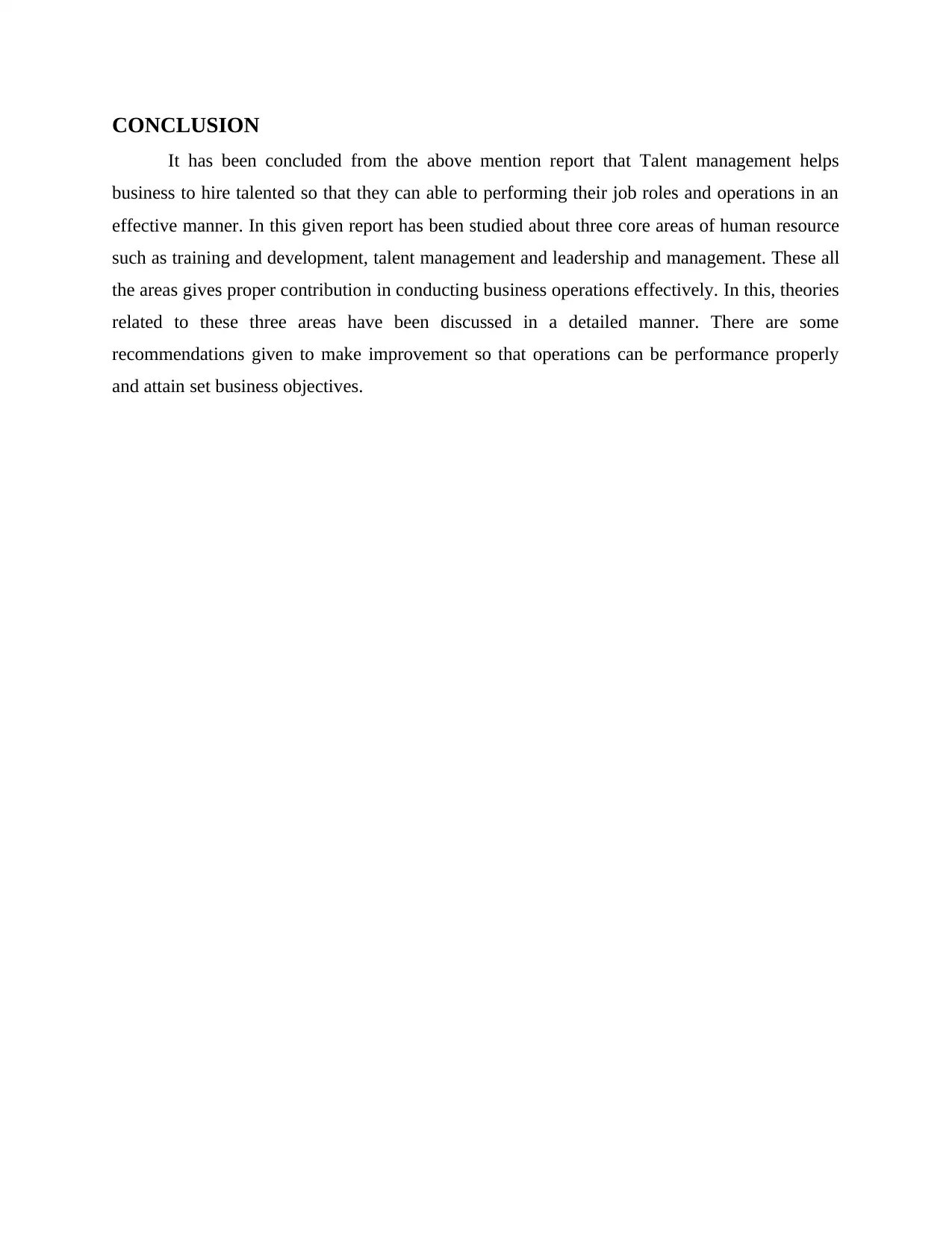
CONCLUSION
It has been concluded from the above mention report that Talent management helps
business to hire talented so that they can able to performing their job roles and operations in an
effective manner. In this given report has been studied about three core areas of human resource
such as training and development, talent management and leadership and management. These all
the areas gives proper contribution in conducting business operations effectively. In this, theories
related to these three areas have been discussed in a detailed manner. There are some
recommendations given to make improvement so that operations can be performance properly
and attain set business objectives.
It has been concluded from the above mention report that Talent management helps
business to hire talented so that they can able to performing their job roles and operations in an
effective manner. In this given report has been studied about three core areas of human resource
such as training and development, talent management and leadership and management. These all
the areas gives proper contribution in conducting business operations effectively. In this, theories
related to these three areas have been discussed in a detailed manner. There are some
recommendations given to make improvement so that operations can be performance properly
and attain set business objectives.
⊘ This is a preview!⊘
Do you want full access?
Subscribe today to unlock all pages.

Trusted by 1+ million students worldwide
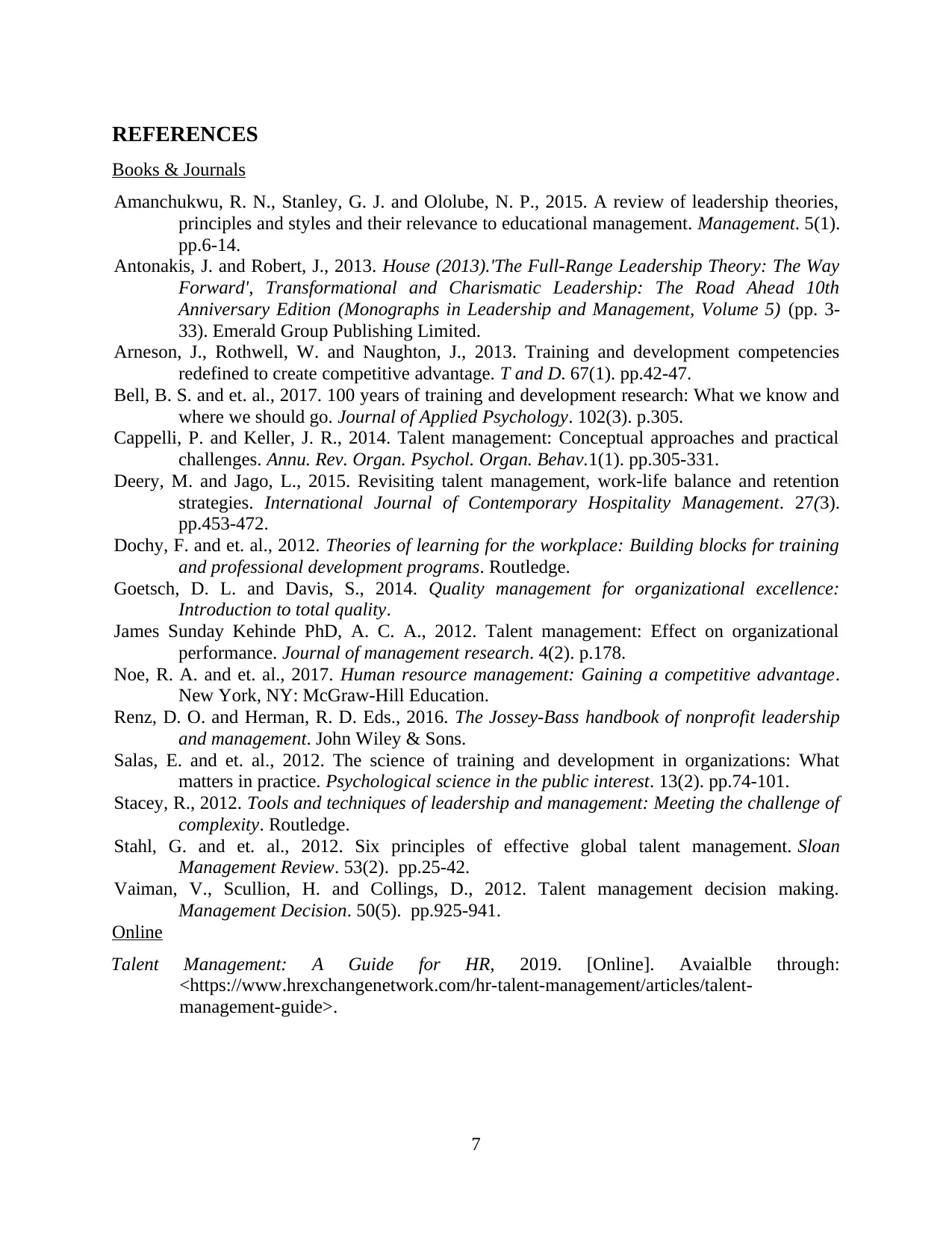
REFERENCES
Books & Journals
Amanchukwu, R. N., Stanley, G. J. and Ololube, N. P., 2015. A review of leadership theories,
principles and styles and their relevance to educational management. Management. 5(1).
pp.6-14.
Antonakis, J. and Robert, J., 2013. House (2013).'The Full-Range Leadership Theory: The Way
Forward', Transformational and Charismatic Leadership: The Road Ahead 10th
Anniversary Edition (Monographs in Leadership and Management, Volume 5) (pp. 3-
33). Emerald Group Publishing Limited.
Arneson, J., Rothwell, W. and Naughton, J., 2013. Training and development competencies
redefined to create competitive advantage. T and D. 67(1). pp.42-47.
Bell, B. S. and et. al., 2017. 100 years of training and development research: What we know and
where we should go. Journal of Applied Psychology. 102(3). p.305.
Cappelli, P. and Keller, J. R., 2014. Talent management: Conceptual approaches and practical
challenges. Annu. Rev. Organ. Psychol. Organ. Behav.1(1). pp.305-331.
Deery, M. and Jago, L., 2015. Revisiting talent management, work-life balance and retention
strategies. International Journal of Contemporary Hospitality Management. 27(3).
pp.453-472.
Dochy, F. and et. al., 2012. Theories of learning for the workplace: Building blocks for training
and professional development programs. Routledge.
Goetsch, D. L. and Davis, S., 2014. Quality management for organizational excellence:
Introduction to total quality.
James Sunday Kehinde PhD, A. C. A., 2012. Talent management: Effect on organizational
performance. Journal of management research. 4(2). p.178.
Noe, R. A. and et. al., 2017. Human resource management: Gaining a competitive advantage.
New York, NY: McGraw-Hill Education.
Renz, D. O. and Herman, R. D. Eds., 2016. The Jossey-Bass handbook of nonprofit leadership
and management. John Wiley & Sons.
Salas, E. and et. al., 2012. The science of training and development in organizations: What
matters in practice. Psychological science in the public interest. 13(2). pp.74-101.
Stacey, R., 2012. Tools and techniques of leadership and management: Meeting the challenge of
complexity. Routledge.
Stahl, G. and et. al., 2012. Six principles of effective global talent management. Sloan
Management Review. 53(2). pp.25-42.
Vaiman, V., Scullion, H. and Collings, D., 2012. Talent management decision making.
Management Decision. 50(5). pp.925-941.
Online
Talent Management: A Guide for HR, 2019. [Online]. Avaialble through:
<https://www.hrexchangenetwork.com/hr-talent-management/articles/talent-
management-guide>.
7
Books & Journals
Amanchukwu, R. N., Stanley, G. J. and Ololube, N. P., 2015. A review of leadership theories,
principles and styles and their relevance to educational management. Management. 5(1).
pp.6-14.
Antonakis, J. and Robert, J., 2013. House (2013).'The Full-Range Leadership Theory: The Way
Forward', Transformational and Charismatic Leadership: The Road Ahead 10th
Anniversary Edition (Monographs in Leadership and Management, Volume 5) (pp. 3-
33). Emerald Group Publishing Limited.
Arneson, J., Rothwell, W. and Naughton, J., 2013. Training and development competencies
redefined to create competitive advantage. T and D. 67(1). pp.42-47.
Bell, B. S. and et. al., 2017. 100 years of training and development research: What we know and
where we should go. Journal of Applied Psychology. 102(3). p.305.
Cappelli, P. and Keller, J. R., 2014. Talent management: Conceptual approaches and practical
challenges. Annu. Rev. Organ. Psychol. Organ. Behav.1(1). pp.305-331.
Deery, M. and Jago, L., 2015. Revisiting talent management, work-life balance and retention
strategies. International Journal of Contemporary Hospitality Management. 27(3).
pp.453-472.
Dochy, F. and et. al., 2012. Theories of learning for the workplace: Building blocks for training
and professional development programs. Routledge.
Goetsch, D. L. and Davis, S., 2014. Quality management for organizational excellence:
Introduction to total quality.
James Sunday Kehinde PhD, A. C. A., 2012. Talent management: Effect on organizational
performance. Journal of management research. 4(2). p.178.
Noe, R. A. and et. al., 2017. Human resource management: Gaining a competitive advantage.
New York, NY: McGraw-Hill Education.
Renz, D. O. and Herman, R. D. Eds., 2016. The Jossey-Bass handbook of nonprofit leadership
and management. John Wiley & Sons.
Salas, E. and et. al., 2012. The science of training and development in organizations: What
matters in practice. Psychological science in the public interest. 13(2). pp.74-101.
Stacey, R., 2012. Tools and techniques of leadership and management: Meeting the challenge of
complexity. Routledge.
Stahl, G. and et. al., 2012. Six principles of effective global talent management. Sloan
Management Review. 53(2). pp.25-42.
Vaiman, V., Scullion, H. and Collings, D., 2012. Talent management decision making.
Management Decision. 50(5). pp.925-941.
Online
Talent Management: A Guide for HR, 2019. [Online]. Avaialble through:
<https://www.hrexchangenetwork.com/hr-talent-management/articles/talent-
management-guide>.
7
1 out of 10
Related Documents
Your All-in-One AI-Powered Toolkit for Academic Success.
+13062052269
info@desklib.com
Available 24*7 on WhatsApp / Email
![[object Object]](/_next/static/media/star-bottom.7253800d.svg)
Unlock your academic potential
Copyright © 2020–2025 A2Z Services. All Rights Reserved. Developed and managed by ZUCOL.




